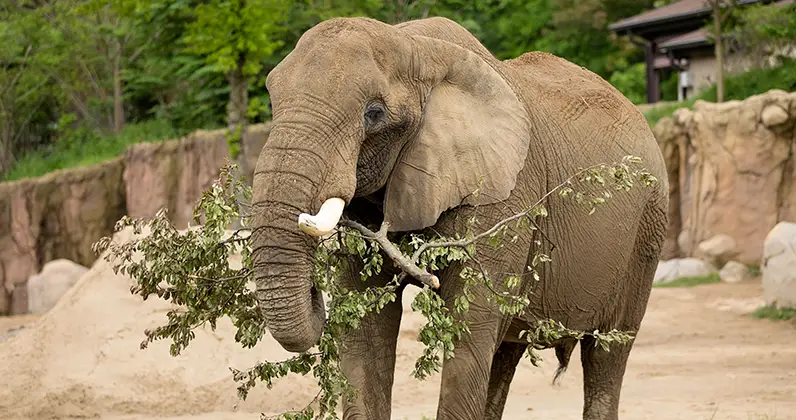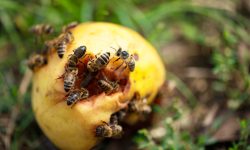Elephants are among the most extraordinary creatures on Earth — powerful, intelligent, and deeply social. These gentle giants roam forests, savannas, and jungles across Africa and Asia, eating almost constantly to sustain their enormous size. But what do elephants eat to stay so strong and majestic?
Despite their size and strength, elephants are strict herbivores, meaning they eat only plant-based foods. However, their diet is incredibly varied — including grasses, leaves, fruits, bark, and roots. Depending on the species and habitat, elephants can consume 200 to 600 pounds (90–270 kg) of food per day and drink up to 50 gallons (190 liters) of water.
Understanding what elephants eat not only reveals how they survive but also shows how vital they are to their ecosystems. Every bite they take helps shape the environment, from clearing forests to spreading seeds. In this article, we’ll explore 20 foods elephants love the most and how these foods help keep them strong, healthy, and truly majestic.
Understanding Elephant Diets

Elephants Are Strict Herbivores
Elephants eat only vegetation — no meat, no insects, and no animal matter. However, their enormous bodies require vast amounts of plant material to maintain energy and body weight. Depending on their species:
-
African savanna elephants primarily eat grasses, shrubs, and tree bark.
-
African forest elephants prefer fruits, leaves, and roots in dense jungles.
-
Asian elephants consume bamboo, palm leaves, and cultivated crops.
Their plant-based diet keeps them healthy while playing a vital role in maintaining biodiversity.
How Elephants Eat
An elephant’s trunk is one of the most versatile feeding tools in the animal kingdom. It acts like a combination of nose, hand, and straw — capable of uprooting grass, breaking branches, and picking up tiny fruits.
Their massive molars grind tough vegetation into digestible pulp. Over a lifetime, elephants replace their teeth up to six times due to constant wear from chewing bark and fibrous plants. When their last set of teeth wears out, it often marks the end of their lifespan, as they can no longer process food effectively.
Time Spent Eating
Elephants can spend 14 to 18 hours per day feeding. Because their digestive systems are not very efficient — only about 50% of what they eat is absorbed — they must eat constantly to meet their nutritional needs. Their dung, rich in undigested seeds and fibers, helps fertilize the soil and spread plant life throughout their habitats.
20 Foods That Keep Elephants Strong and Majestic
1. Grasses
Grass forms the bulk of an elephant’s diet, especially for African savanna species. They graze on a variety of grasses such as Bermuda grass, red oat grass, and spear grass.
Grasses provide carbohydrates, fiber, and essential minerals. During the wet season, elephants enjoy tender green shoots full of nutrients, while in the dry season they rely on coarse, mature stalks.
Their grazing helps keep grasslands healthy by preventing overgrowth and encouraging new plant growth.
2. Tree Bark
Tree bark might not sound appetizing, but for elephants, it’s an important source of fiber, calcium, and roughage. Bark also contains moisture and nutrients, especially when other food sources are scarce.
Elephants use their tusks to strip bark off trees, chewing both the tough outer layer and the nutrient-rich inner bark. This behavior not only nourishes them but also helps shape forests by opening up space for new growth.
Bark from trees like baobab, mopane, and acacia is especially favored.
3. Leaves
Leaves are another major component of an elephant’s diet. They eat the leaves of trees, shrubs, and vines, often pulling down entire branches with their trunks.
Leaves provide vitamins A and C, calcium, and protein — all essential for bone growth and muscle strength. Elephants prefer young, tender leaves, which are easier to chew and richer in nutrients.
In forest regions, elephants act as natural pruners, controlling plant density and promoting regeneration.
4. Fruits
Elephants adore fruits, both wild and cultivated. Depending on their habitat, they may eat bananas, mangoes, jackfruits, marulas, or wild figs.
Fruits supply natural sugars that give elephants quick energy. They also contain water, which helps hydration, and fiber for digestion.
Elephants are also crucial seed dispersers — seeds pass through their digestive systems and are dropped miles away, helping regenerate forests and ecosystems.
5. Roots and Tubers
During dry seasons or droughts, elephants dig into the soil to reach roots and tubers. These underground foods are full of moisture and stored nutrients, making them a vital survival resource.
Using their trunks and tusks, elephants can dig several feet deep to reach edible roots. The process also creates small watering holes and soil aeration, benefiting other animals.
Roots like wild yams and tubers provide steady energy and hydration.
6. Branches and Twigs
Branches and twigs add roughage to an elephant’s diet. They break off limbs from trees using their trunks, chew the wood, and strip the bark.
Although low in calories, twigs help elephants wear down their ever-growing teeth and aid digestion by adding fiber.
Species like acacia and marula are especially popular choices because their branches hold nutritious leaves and pods.
7. Bamboo
Asian elephants consume large quantities of bamboo — both shoots and stems. They strip away the tough outer layer and crush the inner pulp with their molars.
Bamboo is rich in fiber and water content, making it perfect for elephants in tropical climates. During the rainy season, new bamboo shoots become a major part of their diet.
Its fast growth rate ensures a constant food supply for herds living in forest regions.
8. Palm Leaves
Palm leaves are commonly eaten by elephants living near coastal or tropical areas. They use their trunks to tear off fronds and chew the softer midribs.
Palm leaves contain moisture and minerals that help maintain healthy skin and digestion. Elephants also eat the tender shoots of palm trees, which are sweeter and easier to digest.
Species such as coconut and date palms are particularly popular in Asia.
9. Bananas
Bananas are a true elephant delicacy. In regions where banana plants grow, elephants often raid plantations or forests to eat ripe fruit and even the leaves.
Bananas provide quick, natural sugars for energy and potassium for muscle health. The fruit’s soft texture makes it ideal for both adult and young elephants.
In captivity, bananas are often used as treats or rewards for training due to their appealing sweetness.
10. Sugarcane
Elephants love sugarcane for its sweet, juicy stalks. It’s rich in carbohydrates and moisture, giving them both energy and hydration.
In India, Sri Lanka, and parts of Africa, elephants frequently wander into sugarcane fields, causing trouble for farmers — but only because they can’t resist the taste.
A single elephant can consume hundreds of pounds of sugarcane in one sitting, especially before long migrations.
11. Acacia Pods
Acacia trees produce seed pods that elephants find irresistible. These pods are packed with protein, fiber, and natural sugars.
During the dry season, when grasses are scarce, acacia pods become an essential food source. Elephants collect fallen pods or shake trees to release them.
They also help acacia trees by dispersing seeds through their dung — a natural cycle of growth and renewal.
12. Flowers
Flowers may not seem like much, but elephants love them for their sweetness and scent. They eat blossoms from trees and shrubs during blooming seasons.
Flowers like hibiscus, marula, and baobab provide nectar, vitamins, and antioxidants that enhance elephant health.
Their gentle feeding on flowers helps with natural pollination and keeps ecosystems balanced.
13. Tree Sap
When elephants strip bark or break branches, they often lick the sap that flows out. Tree sap contains natural sugars and minerals that serve as a quick energy source.
This sticky substance helps sustain elephants during periods of food scarcity. It’s particularly important in drier habitats where fruits and grasses are limited.
Sap from baobab and mopane trees is especially prized for its hydration benefits.
14. Shrubs and Bushes
Shrubs and bushy plants fill in nutritional gaps, particularly in open savanna habitats. Elephants browse on shrubs like combretum and milkbush, which are rich in calcium and iron.
Shrubs offer roughage and fiber, keeping the digestive system active. They also grow quickly, ensuring a consistent food source.
Young elephants often learn to strip leaves and stems from bushes before tackling larger trees.
15. Water Plants
Elephants living near rivers or wetlands often feed on aquatic vegetation such as reeds, papyrus, and water lilies.
These plants are full of water and easy to chew, making them a great source of hydration. Elephants sometimes wade into ponds or swamps to reach them, cooling their bodies at the same time.
This dual feeding and bathing behavior helps them regulate temperature and maintain healthy skin.
16. Maize and Crops
In agricultural regions, elephants sometimes feed on crops like corn, rice, and millet. These foods are rich in starch and sugar, making them highly attractive.
While this leads to human-elephant conflicts, it’s a testament to their intelligence and adaptability.
Crops provide quick calories and are especially tempting when natural vegetation is dry or scarce.
17. Baobab Fruit
The baobab tree, known as the “tree of life,” produces fruit pods filled with vitamin-rich pulp. Elephants eat the fruit and even chew the bark for its moisture.
Baobab fruit contains vitamin C, calcium, and antioxidants, helping elephants stay strong and hydrated.
Their feeding helps scatter baobab seeds across wide distances, aiding in reforestation.
18. Wild Herbs
Elephants occasionally consume herbs and wild plants like basil, lemongrass, and sage. These herbs add flavor, trace nutrients, and medicinal benefits to their diet.
Some species even use their knowledge of herbs to self-medicate — eating certain plants when sick or injured.
This behavior demonstrates their intelligence and deep understanding of their environment.
19. Clay and Mineral-Rich Soil
Elephants sometimes eat clay or soil from riverbanks. This behavior, known as geophagy, provides essential minerals like sodium and calcium that are missing from plant foods.
Clay also neutralizes toxins found in some plants, helping digestion.
Elephant herds often return to specific mineral-rich spots known as “salt licks” to replenish their nutrient balance.
20. Tree Roots and Stems
Elephants frequently pull up entire plants or trees to eat the roots and stems. These parts are dense with stored nutrients and water.
While this can cause deforestation, it also opens up space for grasslands to regrow, creating new feeding areas for other herbivores.
This powerful feeding behavior highlights elephants’ role as ecosystem engineers.
The Importance of Diet in Elephant Health
Building Strength and Stamina
Elephants’ plant-rich diet provides a balanced mix of carbohydrates, fiber, and minerals that fuel their immense bodies. Their constant grazing keeps muscles strong and digestion active.
Environmental Impact
Every meal elephants take reshapes their habitat. By clearing vegetation, dispersing seeds, and creating water holes, they maintain the balance of savannas and forests.
Without elephants, many ecosystems would lose biodiversity and become overgrown or barren.
Frequently Asked Questions (FAQs)
Do elephants eat meat?
No. Elephants are 100% herbivores and never consume meat or insects. Their digestive systems are specialized for fibrous plants.
How much do elephants eat per day?
An adult elephant can eat 200–600 pounds (90–270 kg) of food daily and spend up to 18 hours foraging.
What do baby elephants eat?
For the first few months, baby elephants drink only their mother’s milk. As they grow, they begin eating soft grass, fruits, and leaves.
Do elephants drink a lot of water?
Yes. Elephants drink up to 50 gallons (190 liters) of water daily. They use their trunks to suck and spray water into their mouths or onto their bodies.
Why do elephants eat dirt or clay?
They eat mineral-rich soil to supplement their diet with nutrients like sodium and calcium and to help neutralize plant toxins.
Conclusion
Elephants are majestic herbivores that survive and thrive on nature’s vegetation. From grasses and bark to fruits and roots, their diet is both diverse and essential to the planet’s health. Every bite an elephant takes nourishes not only its body but also the ecosystems around it.
These magnificent creatures remind us that strength doesn’t always come from meat or aggression — sometimes, it comes from harmony with nature. Protecting elephants means preserving the forests, savannas, and rivers that sustain them — and in turn, sustain us all.






